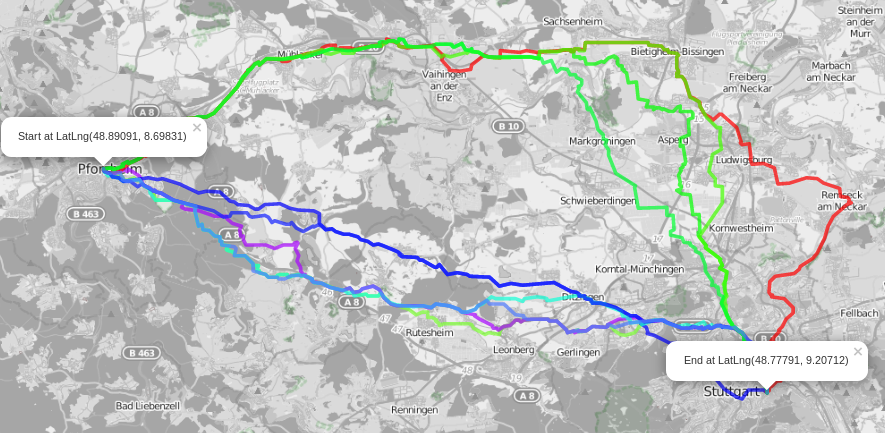Cyclops - an alternative route planning tool for bicycles
Cyclops finds alternative routes between two points using multiple
metrics. Each of the paths is optimal for some combination of the
metrics and sufficiently different from the others according to user
preference. 
It does this fast by using the Dijkstra speed-up technique multicriteria contraction hierarchies.
Cyclops was initially implemented for bicycle routes and three specific metrics. Although the Cyclops back end is capable of handling other metrics and a different number of metrics its front end is only designed for this use case and would need adaption for a different one.
Building
To Build Cyclops first clone it and change into its directory:
git clone --recursive https://github.com/lesstat/cyclops
cd cyclopsThen create a build directory for cmake and run cmake and make.
mkdir build
cd build
cmake ..
make -jUsage
The main executable of Cyclops is cyclops. It has the following cli options:
$ ./build/cyclops -h
-h [ --help ] prints help message
loading options:
-t [ --text ] arg load graph from text file
-b [ --bin ] arg load graph form binary file
--zi input text file is gzipped
-d [ --dimension ] arg Dimension of loaded Graph
actions:
--save arg save graph to binary file
--test runs normal dijkstra and CH dijktra for comparison
-w [ --web ] start webserver for interaction via browserIt needs exactly one of the first two in the loading category to load a graph and at
least one of the second category. --zi can be combined with the
-t option to directly read zip compressed graph files in text
format. -d sets the dimension of the loaded graph. Default
is 3. Dimensions one to three are supported currently. Larger
Dimension can be added easily see below.
The actions are executed in the order they are displayed above.
--save prompts the application
write the graph to a binary file for faster loading (no text parsing necessary).
--test executes 1,000 random source-target queries with Dijkstra
and CH-Dijkstra, assures that they output the same path and prints the
speed-up at the end.
--web starts a web server for interactive use. Cyclops expects a
directory named web with the contents for the web interface at the
current working directory (not the directory the executable is located
in). Starting from the root directory of the repository is currently
mandatory for the web interface. The Web interface is available at
http://localhost:8080/web
Different Number of Metrics
Although Cyclops was initially implemented to handle exactly three metrics, it was adapted to handle an arbitrary number of metrics. For best performance the number of metrics is needed at compile time. If you want to work with more metrics change the switch statement at the bottom of the main function in main.cpp
For four metrics the following lines would need to be added:
case 4: {
return run<4>(vm, loadFileName, saveFileName);
break;
}Graph Data
Cyclops can read road graphs in two different formats. The important one is a text format. The other one is a binary format which Cyclops can write from any valid input graph and read again. It is used for faster reading and writing of graphs which should not be modified any more.
The text format consists of a header and a body.
Header
The header starts with an arbitrary number of lines reserved for
comments. These lines start with and #. They are followed by a
blank line and afterwards three lines defining the contents of the
file:
- Dimension of the cost vector
- Number of nodes
- Number of edges
A header could look like this:
# Creation date: 02.03.2018
# Edge Costs: length, travel time, positive height ascent
3
8456123
17987123
Which means there is a vector of size three assigned to every edge. There are 8,456,123 nodes in the graph and 17,987,123 edges.
As mentioned above Cyclops needs to be compiled with the right dimension for different dimensions to work. This will be checked when the graph is read.
Nodes
Immediately after the header (without a blank line) follows the data for all nodes, one node per line:
0 125799 53.0749415 8.7868047 3.4728513520111997 0
Those values are:
<internal id> <osmid> <latitude> <longitude> <height> <CH-Level>
No two nodes are allowed to have the same internal id. The CH-Level is important for the speeding up the shortest path search. A Ch-Graph can for example be constructed from a normal graph by my multi-ch-constructor.
Cyclops works with a normal graph too, but slowly :-)
Edges
After the last node the edges of the graph start. An edge looks like this:
22 104289 6 0.17316000000255372 1.5 -1 -1
which stands for:
<internal source node id> <internal destinantion node id> <cost 1>
<cost 2> .. <cost dimension> <replaced edge id 1> <replaced edge id 2>
Edges are always one way. The replaced edge ids are for shortcut edges in
a CH-Graph. Normal edges don't replace other edges and there for have
-1 as replaced edge id. An edge is assigned an internal id by the
placement in the file. The first edge has id 0, the second id 1, and
so on.